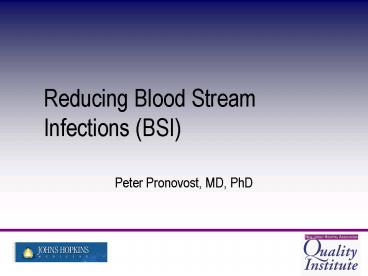Reducing Blood Stream Infections BSI - PowerPoint PPT Presentation
1 / 24
Title:
Reducing Blood Stream Infections BSI
Description:
Check list. CR-BSI Checklist. Before the procedure, did they: Wash hands. Sterilize procedure site ... personnel assisting with procedure follow the above ... – PowerPoint PPT presentation
Number of Views:141
Avg rating:3.0/5.0
Title: Reducing Blood Stream Infections BSI
1
Reducing Blood Stream Infections (BSI)
- Peter Pronovost, MD, PhD
2
The Problem is Large
- 16,000 CR-BSI in U.S. ICUs annually
- Mortality 18 (0-35)
- Annual deaths 500 - 4,000
- Cost per episode 28,690-56,000
- Annual cost 60 - 460 million
- CDC. MMWR 2002 Heiselman JAMA 1994 Dimick Arch
Surg 2001
3
What is the Evidence?
- Guidelines for the Prevention of Intravascular
Catheter-Related Infections August 2002.
www.cdc.gov - Mermel LA. Prevention of Intravascular
Catheter-related Infections. Ann Intern Med
2000132391-402.
4
Strategies for Prevention 5 Key Best Practices
- Remove Unnecessary Lines
- Hand Hygiene
- Use of Maximal Barrier Precautions
- Chlorhexidine for Skin Antisepsis
- Avoid femoral lines
MMWR. 200251RR-10
5
Hand Hygiene The Evidence
- Since 1977, 7 prospective studies have shown
that improvement in hand hygiene significantly
decreases a variety of infectious complications
Larsen. Clin Infect Dis 1999291287-94 Lancet
20003561307-1312
6
What are Maximal Barrier Precautions?
- For Provider
- Hands hygiene
- Non-sterile cap and mask
- All hair should be under cap
- Mask should cover nose and mouth tightly
- Sterile gown and gloves
- For the Patient
- Cover patients head and body with a large
sterile drape
7
Maximal Barrier Precautions
8
Maximal Barrier Precautions The Evidence
Am J Med 199191(3B)197S-205S Infect Control
Hosp Epidemiol 199415231-8
9
Skin Prep Chlorhexidine
Ann Intern Med. 2002136792-801
10
Skin Prep Chlorhexidine
Ann Int Med 2002136792-801
11
What Site is Best?
- RCT of femoral and SC lines in the ICU
- 145 pts femoral/144 pts SC
- Outcomes
- Higher rate of infectious complications in
femoral grp 19.8 vs 4.5 (p lt .001) - Higher rate of thrombotic complications in
femoral grp 21.5 vs. 1.9 (p lt .001) complete
thrombosis 6 vs 0 - Similar rates of mechanical complication 17.3
vs 18.8 (p NS)
JAMA 2001,286700-7
12
Our Baseline Compliance With Best Practice
- Two-week observation period
- Physicians unaware of study
- 26 line insertions
- 8 (31) new central venous access
- 18 (69) for catheter exchanges over a wire
- None were emergent
13
Our Baseline Compliance With Best Practice
- Providers were compliant with best practice
during 62 of the observed procedures
National compliance estimated to be 30
14
To prevent mistakes
- Create culture of safety
- Improve Processes
- Reduce complexity
- Create independent checks for key processes
- Automate
15
Culture
- Training by Hospital epidemiology staff
- Web-based training
- Nurses assist with lines
- Empower nurses to stop line placement
16
Improve Process
- Complexity
- Line cart store all equipment in one place
- Redundancy
- Check list
17
CR-BSI Checklist
- Before the procedure, did they
- Wash hands
- Sterilize procedure site
- Drape entire patient in a sterile fashion
- During the procedure, did they
- Use sterile gloves, mask and sterile gown
- Maintain a sterile field
- Did all personnel assisting with procedure follow
the above precautions
18
CR-BSI Rate
VAD Policy
Checklist
Line Cart
Daily goals
Empower Nursing
19
240 days without a CR-BSIpresent as weeks
without infection
We can eliminate healthcare acquired infections
20
(No Transcript)
21
Outcome and Cost Impact
- Rate of CR-BSIs fell from 11.3 to 0 /1000
catheter days. - Prevented annually (estimated)
- 43 CR-BSIs
- 8 deaths
- 559 ICU days
- Estimated savings to hospital 1,824,447
22
Summary
- Re-defining benchmarks
- Ensure patients receive evidence-based
intervention - Culture
- Complexity
- Redundancy
23
Conclusions
- 5 Evidence-Based Best Practices
- Remove Unnecessary Lines
- Practice Hand Hygiene
- Use Maximal Barrier Precautions
- Apply Chlorhexidine for Skin Antisepsis
- Avoid Femoral Lines
24
Interventions to ensure patient receive evidence
- Education partner with HEIC
- Ask Daily if line needed
- Checklist, nurse must be present
- Empower nurses
- Line cart































